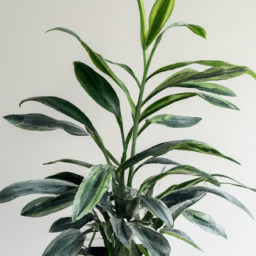
The Importance of Proper Watering for Indoor Plants
Watering is one of the most crucial aspects of caring for indoor plants. It plays a vital role in their overall health and well-being. Proper watering ensures that plants receive the right amount of moisture, which is essential for their growth, development, and survival. In this comprehensive guide, we will delve into the importance of proper watering techniques for indoor plants and provide you with a step-by-step guide to ensure your plants thrive.
1. Understanding the Watering Needs of Indoor Plants
Before diving into the watering process, it is crucial to understand the specific needs of your indoor plants. Different plants have varying water requirements based on factors such as their species, size, growth stage, and environmental conditions. Some plants prefer consistently moist soil, while others thrive in drier conditions.
Research and identify the specific watering needs of each plant in your indoor garden. This knowledge will help you tailor your watering routine accordingly, providing the optimal conditions for their growth. It is important to note that overwatering can be just as detrimental as underwatering, so striking the right balance is key.
Factors such as humidity levels, temperature, and air circulation within your indoor space also impact the watering needs of your plants. Keep these factors in mind as you develop your watering routine.
2. Signs of Underwatering and Overwatering
Knowing how to identify signs of underwatering or overwatering is crucial for maintaining the health of your indoor plants. By observing your plants closely, you can address any watering issues promptly and prevent potential damage.
Signs of underwatering include wilting leaves, dry soil, and drooping stems. The plant may appear weak and lack vibrancy. On the other hand, overwatering can lead to yellowing leaves, root rot, and a foul odor. The soil may feel excessively wet, and the plant may show signs of mold or fungus growth.
Regularly check the moisture level of the soil by inserting your finger about an inch deep into the soil. If it feels dry, it’s time to water. If it feels moist, wait a bit longer before watering again. This simple test can help you prevent both underwatering and overwatering.
3. Watering Techniques for Indoor Plants
Now that you understand the watering needs of your indoor plants and how to identify signs of underwatering or overwatering, let’s explore some effective watering techniques.
a. The Soak and Dry Method: This method is suitable for plants that prefer drier conditions. Thoroughly water the plant until water drains out from the bottom of the pot. Allow the soil to dry out completely before watering again. This method mimics the natural rainfall patterns and prevents overwatering.
b. Bottom Watering: This technique is useful for plants that are prone to root rot or those with delicate foliage. Place the potted plant in a tray filled with water and allow it to soak up moisture from the bottom. Once the topsoil feels moist, remove the plant from the tray and let any excess water drain away.
c. Mist or Spray Method: Some plants, especially those native to humid environments, benefit from regular misting or spraying. Use a spray bottle filled with room temperature water to lightly mist the foliage. This helps increase humidity levels around the plant and prevents the leaves from drying out.
Conclusion
Proper watering is essential for the health and vitality of your indoor plants. Understanding the specific watering needs of each plant, identifying signs of underwatering or overwatering, and implementing effective watering techniques are key to ensuring their well-being. Remember to strike a balance between providing enough moisture and avoiding excess water. By following the step-by-step guide in this comprehensive watering guide, you can create an optimal watering routine that will help your indoor plants thrive.
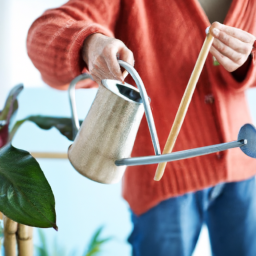
Understanding the Watering Needs of Different Types of Indoor Plants
Introduction
Indoor plants bring life and beauty to our homes, but they also require proper care to thrive. One of the most crucial aspects of plant care is watering. Understanding the watering needs of different types of indoor plants is essential to ensure their health and longevity. In this comprehensive guide, we will delve into the various factors that influence watering requirements and provide you with a step-by-step approach to watering indoor plants effectively.
Factors Affecting Watering Needs
Watering needs can vary significantly depending on several factors. It’s important to consider these factors to determine the appropriate watering schedule for your indoor plants.
1. Plant Species
Different plant species have varying water requirements. Some plants, like succulents and cacti, are adapted to arid environments and require infrequent watering. On the other hand, tropical plants such as ferns and orchids prefer consistently moist soil. Researching the specific needs of your plant species will help you understand their watering requirements better.
2. Plant Size
The size of your indoor plants also affects their watering needs. Larger plants generally require more water than smaller ones as they have a larger root system and more foliage to support. However, it’s essential to avoid overwatering large plants, as excessive moisture can lead to root rot and other issues. Always consider the size of your plants when determining the watering frequency.
3. Environmental Conditions
The environment in which your indoor plants are placed plays a significant role in their watering needs. Factors such as temperature, humidity levels, and air circulation affect the rate at which plants lose moisture through transpiration. Plants placed in warmer and drier environments may require more frequent watering compared to those in cooler and more humid conditions. Additionally, air-conditioned or heated rooms can also impact the moisture levels in the soil.
4. Potting Medium and Drainage
The type of potting medium and the drainage system in your plant’s container can influence its watering requirements. Well-draining soil mixes allow excess water to escape, preventing waterlogged roots. On the other hand, heavy soils or pots without drainage holes can retain water for longer, increasing the risk of overwatering. Understanding the characteristics of your potting medium and ensuring proper drainage is crucial for maintaining optimal soil moisture levels.
Step-by-Step Guide to Watering Indoor Plants
Now that we have explored the factors that affect watering needs, let’s dive into a step-by-step guide to watering your indoor plants effectively.
1. Check Soil Moisture
Before watering your plants, always check the moisture level of the soil. Insert your finger about an inch deep into the soil. If it feels dry, it’s time to water. If it’s still moist, hold off on watering for a few more days. Remember, overwatering is one of the leading causes of plant problems, so it’s better to err on the side of underwatering.
2. Watering Techniques
When it’s time to water your indoor plants, there are a few techniques you can employ to ensure proper hydration.
a. Bottom Watering
For plants with sensitive foliage or those prone to fungal diseases, bottom watering is an effective method. Place the plant’s pot in a tray filled with water and allow it to soak up moisture through the drainage holes. Once the topsoil feels moist, remove the pot from the tray and let any excess water drain out.
b. Top Watering
Top watering is the most common method and works well for most indoor plants. Slowly pour water onto the soil until it starts draining from the bottom of the pot. Ensure even distribution of water around the plant’s root zone, avoiding excessive water on the foliage.
3. Watering Frequency
Determining the frequency of watering is crucial to prevent both underwatering and overwatering. As mentioned earlier, factors such as plant species, size, environmental conditions, and potting medium influence watering needs. However, a general rule of thumb is to water indoor plants when the top inch of soil feels dry. Avoid setting a fixed watering schedule and instead rely on the moisture level of the soil.
4. Monitor and Adjust
Regularly monitor your plants for signs of overwatering or underwatering. Wilting, yellowing leaves, and a musty odor indicate overwatering, while dry, crispy leaves suggest underwatering. Adjust your watering frequency accordingly to meet the specific needs of your indoor plants.
5. Consider Seasonal Changes
Remember that watering needs can change with the seasons. During the warmer months, plants may require more frequent watering due to increased evaporation. In contrast, colder months may necessitate reduced watering as plants enter dormancy. Always observe your plants closely and adapt your watering routine accordingly.
Conclusion
Watering indoor plants may seem like a simple task, but it requires careful consideration of various factors. By understanding the watering needs of different types of indoor plants and following a step-by-step guide, you can ensure that your plants receive the right amount of moisture for optimal growth. Remember to monitor your plants regularly, adjust watering frequency as needed, and provide a suitable environment to keep your indoor plants healthy and thriving.
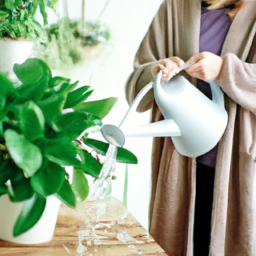
Signs of Underwatering and Overwatering Indoor Plants
Watering indoor plants is a crucial aspect of plant care, and finding the right balance can be a bit tricky. Overwatering or underwatering can lead to various problems that can harm the health and growth of your beloved plants. In this comprehensive guide, we will explore the signs of both underwatering and overwatering, helping you become an expert in keeping your indoor plants happy and thriving.
Signs of Underwatering Indoor Plants
Underwatering is a common issue that many indoor plant owners face. It occurs when the plants do not receive enough water to sustain their growth and development. Here are some signs to look out for if you suspect your indoor plants are underwatered:
1. Dry Soil: One of the most obvious signs of underwatering is dry soil. If you notice that the soil feels dry to the touch, it is a clear indication that your plant needs watering. However, keep in mind that some plants prefer slightly drier soil, so it’s essential to know the specific needs of your plant species.
2. Wilting Leaves: When a plant lacks water, its leaves may start to wilt. This is a defense mechanism employed by the plant to reduce water loss through transpiration. If you notice your plant’s leaves drooping or becoming soft, it’s a sign that they need a drink.
3. Yellowing Leaves: Another common sign of underwatering is the yellowing of leaves. When a plant doesn’t receive enough water, it can’t perform vital processes like photosynthesis properly. As a result, the leaves may turn yellow, indicating a lack of nutrients and water.
4. Stunted Growth: Underwatered plants often experience stunted growth. If you notice that your plant is not growing as vigorously as it used to or if new leaves are smaller than usual, it’s a sign that it is not receiving enough water to support its growth.
5. Dry and Crispy Edges: One of the telltale signs of underwatering is dry and crispy leaf edges. As the plant struggles to get enough water, it prioritizes supplying water to the vital parts, leaving the edges of the leaves dry and brittle.
6. Slow Recovery: When you water an underwatered plant, it may take longer than usual for it to recover. The plant needs time to absorb water and rehydrate its tissues, so don’t be discouraged if you don’t see immediate improvement.
7. Root Problems: Underwatering can lead to root problems such as root rot or root dehydration. If you notice a foul smell, mushy roots, or roots that appear dry and shriveled, it’s a sign that your plant has been underwatered for an extended period.
Signs of Overwatering Indoor Plants
Overwatering is equally detrimental to indoor plants as underwatering. It occurs when plants receive more water than they need, leading to root suffocation and other issues. Here are some signs to look out for if you suspect your indoor plants are overwatered:
1. Wet Soil: The most apparent sign of overwatering is wet soil. If the soil feels consistently damp or waterlogged, it’s a clear indication that you are overwatering your plant. Over time, this can lead to root rot and other fungal diseases.
2. Yellowing and Dropping Leaves: Overwatered plants often develop yellowing leaves that eventually fall off. The excess moisture prevents the roots from receiving adequate oxygen, leading to root damage and nutrient deficiencies.
3. Mold and Fungus Growth: Excessive moisture creates a favorable environment for mold and fungus growth. If you notice moldy or fuzzy patches on the soil surface or the plant itself, it’s a sign that your plant is suffering from overwatering.
4. Root Rot: Overwatering can cause root rot, a condition where the roots become mushy, discolored, and foul-smelling. If you gently remove the plant from its pot and observe these symptoms, it’s crucial to take immediate action to save your plant.
5. Wilting Despite Moist Soil: Paradoxically, overwatered plants may exhibit wilting despite the soil being moist. This occurs because the roots are damaged and cannot effectively absorb water, leading to dehydration and wilting.
6. Slowed Growth: Overwatered plants often experience slowed growth. The excess moisture hampers the plant’s ability to absorb nutrients, leading to stunted growth and weak, leggy stems.
7. Pests and Diseases: Overwatered plants are more susceptible to pests and diseases. The weakened state of the plant due to root damage makes it an easy target for pests like fungus gnats and diseases like powdery mildew.
By being aware of these signs, you can quickly identify whether your indoor plants are underwatered or overwatered. Remember, it’s essential to understand the specific watering needs of each plant species to provide them with the right amount of water. With proper watering, your indoor plants will thrive and bring beauty to your home or office space.
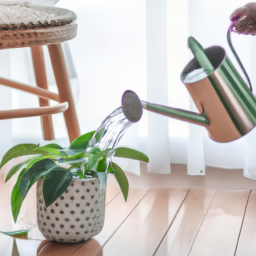
Best Practices for Watering Indoor Plants: Frequency and Techniques
Introduction
Indoor plants are a wonderful addition to any home or office space. They not only bring life and beauty to the surroundings but also provide numerous health benefits. However, to ensure their optimal growth and longevity, proper watering is crucial. Watering indoor plants may seem like a simple task, but there are several factors to consider, such as frequency and techniques. In this comprehensive guide, we will delve into the best practices for watering indoor plants, providing you with step-by-step instructions and valuable insights.
Understanding Water Needs
Before diving into the watering techniques, it is important to understand the water needs of indoor plants. Different plants have varying requirements, depending on factors such as species, size, and environmental conditions. Some plants prefer consistently moist soil, while others thrive in drier conditions. Therefore, it is essential to research the specific needs of your indoor plants to ensure their well-being.
Identifying Signs of Thirst
Observing your plants for signs of thirst is a key aspect of watering indoor plants effectively. Some common signs of dehydration include drooping leaves, dry soil, and yellowing foliage. However, it is important to note that these signs may also indicate other issues, such as overwatering or nutrient deficiencies. Therefore, it is crucial to assess the overall health of the plant and consider multiple factors before determining if watering is required.
Factors Influencing Watering Frequency
Several factors influence the frequency of watering indoor plants. These include the type of plant, pot size, humidity levels, temperature, and the amount of light received. Plants in smaller pots or those exposed to higher temperatures and lower humidity levels may require more frequent watering. On the other hand, larger pots and plants in cooler or more humid environments may need less frequent watering. It is important to strike a balance and avoid both underwatering and overwatering.
Testing Soil Moisture
One effective way to determine if your indoor plants need watering is by testing the moisture level of the soil. You can do this by inserting your finger about an inch into the soil. If it feels dry at this depth, it is likely time to water the plant. However, if the soil feels damp or moist, it is best to hold off on watering to prevent overhydration. Alternatively, you can use a moisture meter, readily available at gardening stores, to accurately measure the moisture content of the soil.
Watering Techniques
Now that we have covered the basics of understanding water needs, let’s explore some effective watering techniques for indoor plants.
Choosing the Right Water
Using the right type of water is essential for the overall health of your indoor plants. Tap water is generally safe for most plants, but it may contain chemicals such as chlorine or fluoride that can be harmful in large quantities. If possible, allow tap water to sit overnight before using it to water your plants, as this will help dissipate any harmful chemicals. Alternatively, you can use filtered or distilled water, which is free from impurities and chemicals. It is important to avoid using water that is too cold, as extreme temperatures can shock the plant’s roots.
Watering Methods
There are several effective watering methods you can employ for indoor plants. The most common methods include:
1. Pouring water directly into the pot: This method involves pouring water directly into the pot until it starts to drain out from the bottom. This ensures thorough watering and helps flush out any accumulated salts or minerals.
2. Bottom watering: This technique involves placing the plant pot in a shallow tray or saucer filled with water. The plant will absorb water through the drainage holes at the bottom of the pot. This method is particularly useful for plants with delicate foliage or those prone to fungal diseases, as it prevents water from splashing onto the leaves.
3. Using a watering can or spray bottle: For plants that require gentle watering, such as those with fine foliage or epiphytic plants like orchids, using a watering can or spray bottle is ideal. This allows you to control the water flow and target specific areas without causing damage.
Watering Techniques for Different Plant Types
Different types of indoor plants have varying watering requirements. Let’s explore some specific techniques for common plant categories:
1. Succulents and cacti: Succulents and cacti are known for their ability to store water in their leaves and stems. These plants prefer infrequent watering, allowing the soil to dry out between waterings. It is important to water them deeply but sparingly, ensuring the excess water drains out completely.
2. Leafy greens and herbs: Plants like lettuce, spinach, and herbs require consistent moisture. It is best to water them when the top inch of soil feels dry. Ensure thorough watering while allowing excess water to drain out, preventing waterlogging.
3. Tropical plants: Tropical plants, such as ferns and peace lilies, thrive in humid environments. They prefer consistently moist soil but not waterlogged conditions. Regularly misting the leaves or using a pebble tray filled with water beneath the pot can help maintain the desired humidity levels.
Conclusion
Watering indoor plants is a crucial aspect of their care and maintenance. By understanding the water needs of your plants, observing signs of thirst, and employing appropriate watering techniques, you can ensure their optimal growth and longevity. Remember to research the specific requirements of your indoor plants and consider factors such as pot size, humidity levels, and temperature. With proper watering practices, your indoor plants will flourish, bringing beauty and vitality to your surroundings.
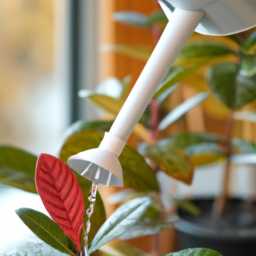
Choosing the Right Watering Tools and Containers for Indoor Plants
Introduction
Indoor plants require proper care and attention to thrive in our homes. One crucial aspect of their care is watering, which plays a significant role in their overall health and growth. To ensure your indoor plants receive the right amount of water, it is essential to choose the appropriate watering tools and containers. In this comprehensive guide, we will explore the various options available and discuss their advantages and disadvantages, helping you make an informed decision for your indoor plants.
Watering Tools
1. Watering Cans
Watering cans are a classic and versatile tool for watering indoor plants. They come in various sizes, shapes, and materials, allowing you to choose one that suits your needs and preferences. Plastic watering cans are lightweight and easy to handle, while metal ones are more durable but slightly heavier. Look for cans with a long spout, as it provides better control and prevents water from splashing onto the leaves.
When using a watering can, ensure that the water is at room temperature, as cold water can shock the plants. Aim to water the soil directly around the plant’s base, avoiding the foliage to prevent diseases and fungal growth. Slowly pour the water, allowing it to penetrate the soil gradually. If you have multiple plants, consider getting a watering can with a narrow spout to reach plants in tight spaces.
2. Watering Wands
Watering wands are excellent tools for reaching plants in hanging baskets or tall pots. They consist of a long tube with a watering nozzle attached at one end and a handle at the other. Some watering wands have adjustable nozzles, allowing you to control the water flow. These tools provide a gentle and targeted stream of water, making it easier to avoid overwatering or damaging delicate foliage.
To use a watering wand effectively, hold it at a comfortable height and direct the water towards the soil around the plant. Move the wand in a circular motion to ensure even watering. Take care not to spray the water too forcefully, as it may dislodge the soil or damage the plant’s roots. Watering wands are particularly useful for plants with dense foliage or those placed in hard-to-reach areas.
3. Spray Bottles
Spray bottles are handy tools for watering small indoor plants or those that require a more delicate touch. They provide a fine mist of water, allowing you to hydrate the plants without overwhelming them. Spray bottles are especially useful for plants that prefer higher humidity levels, such as ferns or orchids. Additionally, they can be used for foliar feeding or misting the leaves to remove dust and improve their appearance.
When using a spray bottle, ensure that the nozzle is set to mist or a fine spray pattern. Hold the bottle at a distance from the plant, spraying the water evenly over the foliage. Avoid using cold water, as it may shock the plants or cause water droplets to remain on the leaves, potentially leading to fungal issues. Refill the spray bottle regularly to ensure a consistent water supply for your plants.
Containers
1. Plastic Pots
Plastic pots are a popular choice for indoor plants due to their affordability, lightweight nature, and versatility. They come in various sizes, colors, and designs, allowing you to find the perfect match for your plant’s needs and your interior decor. Plastic pots also retain moisture better than clay or ceramic pots, reducing the frequency of watering required.
When selecting plastic pots, ensure they have drainage holes at the bottom to prevent waterlogging. Without proper drainage, excess water can accumulate, leading to root rot and other issues. Consider using saucers or trays underneath the pots to catch any excess water and protect your furniture or flooring.
2. Clay Pots
Clay pots, also known as terracotta pots, are a traditional and aesthetically pleasing option for indoor plants. They are porous and allow air and water to pass through, promoting better drainage and preventing waterlogged soil. Clay pots also provide insulation, keeping the plant’s roots cooler during hot weather.
When using clay pots, soak them in water before planting to prevent them from absorbing too much moisture from the soil. While clay pots offer excellent drainage, they can dry out quickly, requiring more frequent watering. Monitor the soil moisture levels regularly and adjust your watering routine accordingly.
3. Self-Watering Containers
Self-watering containers are a convenient option for busy plant enthusiasts or those who tend to overwater their plants. These containers feature a reservoir at the bottom that holds water, which is gradually absorbed by the plant’s roots through a wicking system. This ensures a steady supply of water, preventing both underwatering and overwatering.
When using self-watering containers, it is crucial to monitor the water level in the reservoir and refill it when necessary. This system allows the plants to take up water as needed, reducing the risk of root rot or water stress. Self-watering containers are particularly beneficial for plants that prefer consistently moist soil, such as peace lilies or spider plants.
Conclusion
Choosing the right watering tools and containers is essential for the successful care of your indoor plants. Watering cans, watering wands, and spray bottles each have their advantages and are suitable for different plant types and situations. Plastic pots, clay pots, and self-watering containers offer various benefits, such as drainage, moisture retention, and convenience. By selecting the appropriate tools and containers, you can ensure your indoor plants receive the right amount of water, promoting their growth and overall well-being. Remember to always consider the specific needs of your plants and adjust your watering routine accordingly.
Frequently Asked Questions (FAQ)
1. How often should I water my indoor plants?
It depends on the type of plant and its specific needs. Some plants require more frequent watering, while others prefer to dry out between waterings. As a general rule, check the soil moisture level before watering and adjust accordingly.
2. How can I determine if my indoor plant needs water?
Check the soil moisture by inserting your finger about an inch deep into the soil. If it feels dry, it’s time to water. Additionally, some plants may show visible signs of wilting or drooping when they need water.
3. Should I use tap water or filtered water for watering indoor plants?
Tap water is generally fine for most indoor plants, but some sensitive plants may benefit from using filtered or distilled water. Tap water containing high levels of chlorine or fluoride can be harmful to certain plants, so it’s worth considering the quality of your tap water.
4. How much water should I give my indoor plants?
The amount of water needed depends on factors such as the plant’s size, pot size, and environmental conditions. Water until it starts draining out of the bottom of the pot, ensuring the entire root system is adequately hydrated. Avoid overwatering, as it can lead to root rot.
5. Can I use a self-watering system for my indoor plants?
Yes, self-watering systems can be a convenient way to maintain proper moisture levels for your indoor plants. However, it’s essential to monitor the system regularly to prevent overwatering or under watering.
6. Is misting beneficial for indoor plants?
Misting can provide some humidity to certain plants, especially those that thrive in a humid environment. However, it’s not necessary for all indoor plants. Research the specific needs of your plant to determine if misting is beneficial.
7. Should I water indoor plants from the top or bottom?
Watering from the top is the most common method, allowing water to reach the roots through the soil. However, bottom watering can be useful for certain plants with sensitive leaves or those prone to fungal diseases. It involves placing the pot in a tray of water and allowing the plant to absorb water through the drainage holes.
8. Can I use leftover water from cooking or steaming for my indoor plants?
Using leftover water from cooking or steaming, as long as it’s not salted or flavored, can be a great way to reuse water and provide nutrients to your plants. Just make sure the water has cooled down before using it.
9. What are some signs of overwatering indoor plants?
Signs of overwatering include yellowing leaves, wilting despite moist soil, moldy or musty smell, and the presence of fungus gnats. If you notice these signs, adjust your watering routine and allow the soil to dry out before watering again.
10. Can I use a moisture meter to determine when to water my indoor plants?
Yes, a moisture meter can be a helpful tool to accurately gauge the moisture level of the soil. Insert the probe into the soil and check the reading. However, it’s still essential to visually inspect the plant and consider other factors like environmental conditions.

James Wong is a renowned ethnobotanist, plant scientist, and local television presenter. With a passion for demystifying plant science, he is known for translating complex botanical concepts into practical advice for everyday plant enthusiasts. James’s expertise spans from traditional gardening to cutting-edge plant technologies, making his insights accessible and informative.


